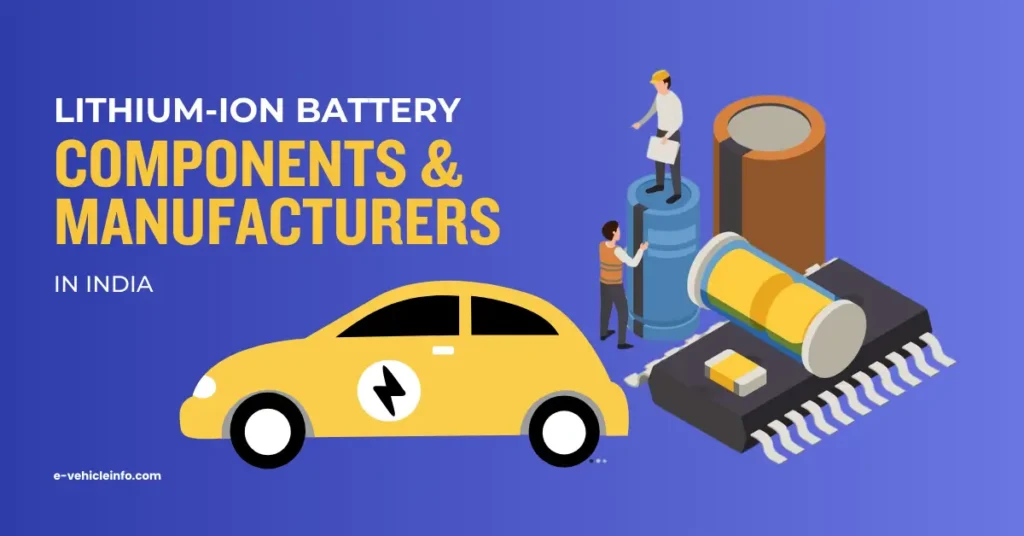
Batteries are the biggest source of energy and the driver of the future.
Everything we see today runs on batteries. So, these batteries are more important than most of us realize. Batteries are the heart of electric vehicles.
As the trend of electric vehicles is growing in India as well as across the world, it becomes very important for us to understand who is the battery market leader in India, especially lithium-ion batteries for electric vehicles.
In this article, we will look at the list of top lithium-ion battery manufacturers and their component manufacturers, which are expected to hold more than 77.3% share in the Indian market by 2024. So let’s first look at the data.
Following are the Top 5 Lithium-ion Batteries Manufacturers in India.
| Sr. No | Company | Headquarters |
| 1 | Amara Raja Batteries Ltd | Tirupati |
| 2 | Exide Industries | Kolkata |
| 3 | TDSG | Gujarat |
| 4 | Tata Chemicals | Mumbai |
| 5 | Luminous Power Technologies | Haryana |
The Li-ion battery has established itself as the technology of reference in the future world of electric cars. A lithium-ion battery is a rechargeable battery used in electric vehicles as well as portable electronics.
Lithium-ion batteries are the clear winner, with very little risk for their businesses to be threatened by alternatives such as other advanced batteries or supercapacitors.
The largest market for lithium-ion batteries will remain electric vehicles, from 2020-2030.
The most common type of battery used in EVs is the lithium-ion battery. These batteries are also used in portable electronics, even in cell phones and computers.
Li-ion batteries have high energy efficiency, a high power-to-weight ratio, and good high-temperature performance. This means, batteries hold a lot of energy for their lesser weight, which is required for electric cars.
The lesser the weight, the longer the car can travel on a single charge (By Newton’s First Law of Motion). Lithium-ion batteries have a low self-discharge rate, meaning they are better than most other batteries at holding a full charge over time.
Li-ion batteries consist of primarily four main components: Cathode, Anode, Electrolyte, and Separator. Every element of a Li-ion battery is essential as it cannot function when one of the components is missing.
The fundamental principle behind the working of a lithium-ion battery is to circulate electrons by creating a potential difference. Each cell of a lithium-battery contains two electrodes immersed in a conductive liquid called the electrolyte.
While recharging the electric vehicle battery, the charger transfers electrons from the positive electrode i.e., the anode to the negative electrode i.e., the cathode. Contrarily, when the car is in motion, the electric vehicle motor uses the current generated by the flow of electrons, leaving the cathode to return to the anode.
The lithium-ion battery uses lithium ions (Li+): hence the name given to this technology. An added advantage is that most of the lithium-ion battery parts are recyclable, making these batteries a very good choice for the environment as well.
The main difference between both these batteries is that lithium-ion batteries use a liquid electrolyte to regulate flow, whereas solid-state batteries use a solid electrolyte. A solid electrolyte will provide a much more compact size with higher energy density, longer lifespan, and increased safety.
They have higher energy density and cost less. They are essentially a group of rigid electricity-generating compartments, consisting of three pieces: a positive electrode, a negative electrode, and an electrolyte (liquid chemical compound between them).
Unlike more traditional ones, most lithium-ion batteries also include an electronic controller, which regulates power and discharge flow, so your battery doesn’t overheat or explode.
They are lightweight and have improved safety. However, their cost is high as compared to lithium-ion. Also, the energy density of Li-Po batteries compared to Li-Ion Batteries is relatively less. In Li-Po batteries, the electrolyte used isn’t a liquid.
Instead, Li-Po batteries use one of these three forms: a dry solid, (it was phased out during the prototype years of lithium polymer batteries) a porous chemical compound, or a gel-like electrolyte.
The battery system is a significant part of an Electric vehicle. The different varieties of Li-Ion batteries are currently the most dominant battery types used in EVs. Because of increasing demand, there is a requirement for better performance of batteries in terms of reduced weight, better cycling ability, recyclable materials, general battery performance, and better driving range.
“Next-Gen Batteries to Power Up Electric Vehicle Installed Base to 100 Million by 2028.” The next generation of electric vehicle batteries will be solid-state batteries, where the liquid electrolyte is replaced with a solid and conductive material.
This will provide a high specific energy rate that will provide an improvement over today’s Li-ion batteries. BMW and Solid Power have joint ventures to develop a new solid-state battery for EVs. Nexeon, a UK-based company, is researching new materials based on silicon to replace carbon in the anode, which will double the range of EVs.
This post was last modified on December 24, 2024 4:07 pm
In a major stride toward sustainable mobility, the Himachal Pradesh Police have incorporated six custom-modified Tata Curvv electric vehicles into…
In India, the automotive and transport industry is undergoing significant changes. This transformation isn't just about improving roads and infrastructure;…
Montra Electric, the clean mobility brand from the prestigious Murugappa Group, has launched the All-New Super Auto, a next-generation electric…
Union Minister Nitin Gadkari (Minister of Road Transport and Highways of India) has once again made a bold statement that’s got…
India’s electric four-wheeler (E4W) market slowed in September 2025, following a record-breaking August, with 15,038 units sold, representing an 18%…
India’s EV market hit 1,04,056 electric two-wheeler sales in September 2025. TVS, Bajaj, and Ather led the chart, while Ola…
This website uses cookies.